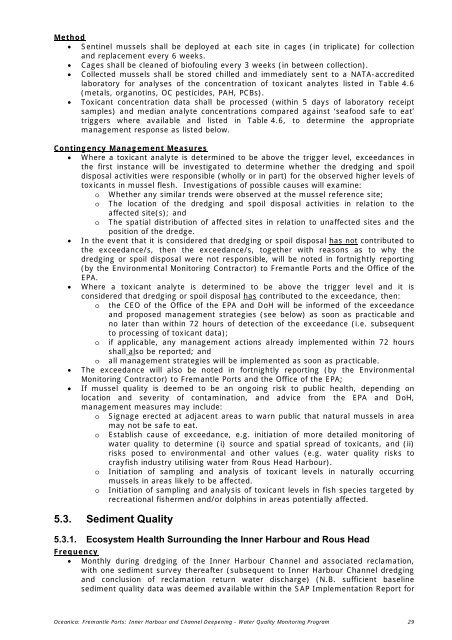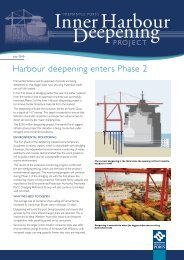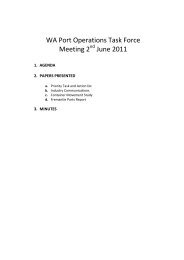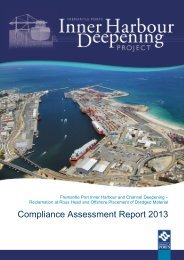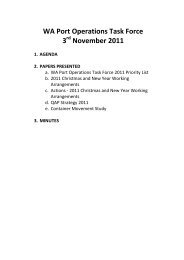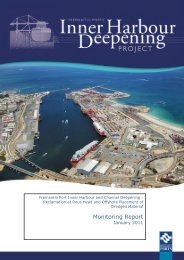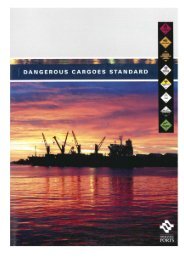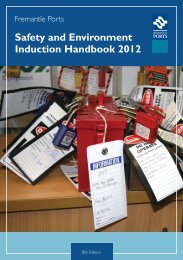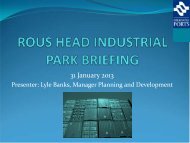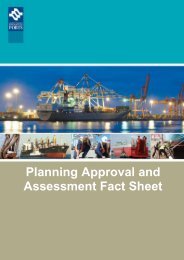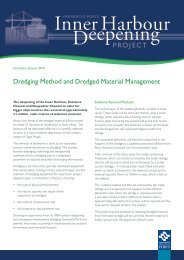Fremantle Port Inner Harbour and Channel ... - Fremantle Ports
Fremantle Port Inner Harbour and Channel ... - Fremantle Ports
Fremantle Port Inner Harbour and Channel ... - Fremantle Ports
Create successful ePaper yourself
Turn your PDF publications into a flip-book with our unique Google optimized e-Paper software.
Method<br />
• Sentinel mussels shall be deployed at each site in cages (in triplicate) for collection<br />
<strong>and</strong> replacement every 6 weeks.<br />
• Cages shall be cleaned of biofouling every 3 weeks (in between collection).<br />
• Collected mussels shall be stored chilled <strong>and</strong> immediately sent to a NATA-accredited<br />
laboratory for analyses of the concentration of toxicant analytes listed in Table 4.6<br />
(metals, organotins, OC pesticides, PAH, PCBs).<br />
• Toxicant concentration data shall be processed (within 5 days of laboratory receipt<br />
samples) <strong>and</strong> median analyte concentrations compared against ‘seafood safe to eat’<br />
triggers where available <strong>and</strong> listed in Table 4.6, to determine the appropriate<br />
management response as listed below.<br />
Contingency Management Measures<br />
• Where a toxicant analyte is determined to be above the trigger level, exceedances in<br />
the first instance will be investigated to determine whether the dredging <strong>and</strong> spoil<br />
disposal activities were responsible (wholly or in part) for the observed higher levels of<br />
toxicants in mussel flesh. Investigations of possible causes will examine:<br />
o Whether any similar trends were observed at the mussel reference site;<br />
o The location of the dredging <strong>and</strong> spoil disposal activities in relation to the<br />
o<br />
affected site(s); <strong>and</strong><br />
The spatial distribution of affected sites in relation to unaffected sites <strong>and</strong> the<br />
position of the dredge.<br />
• In the event that it is considered that dredging or spoil disposal has not contributed to<br />
the exceedance/s, then the exceedance/s, together with reasons as to why the<br />
dredging or spoil disposal were not responsible, will be noted in fortnightly reporting<br />
(by the Environmental Monitoring Contractor) to <strong>Fremantle</strong> <strong>Port</strong>s <strong>and</strong> the Office of the<br />
EPA.<br />
• Where a toxicant analyte is determined to be above the trigger level <strong>and</strong> it is<br />
considered that dredging or spoil disposal has contributed to the exceedance, then:<br />
o<br />
the CEO of the Office of the EPA <strong>and</strong> DoH will be informed of the exceedance<br />
<strong>and</strong> proposed management strategies (see below) as soon as practicable <strong>and</strong><br />
no later than within 72 hours of detection of the exceedance (i.e. subsequent<br />
to processing of toxicant data);<br />
o if applicable, any management actions already implemented within 72 hours<br />
shall also be reported; <strong>and</strong><br />
o all management strategies will be implemented as soon as practicable.<br />
• The exceedance will also be noted in fortnightly reporting (by the Environmental<br />
Monitoring Contractor) to <strong>Fremantle</strong> <strong>Port</strong>s <strong>and</strong> the Office of the EPA;<br />
• If mussel quality is deemed to be an ongoing risk to public health, depending on<br />
location <strong>and</strong> severity of contamination, <strong>and</strong> advice from the EPA <strong>and</strong> DoH,<br />
management measures may include:<br />
o<br />
o<br />
o<br />
o<br />
Signage erected at adjacent areas to warn public that natural mussels in area<br />
may not be safe to eat.<br />
Establish cause of exceedance, e.g. initiation of more detailed monitoring of<br />
water quality to determine (i) source <strong>and</strong> spatial spread of toxicants, <strong>and</strong> (ii)<br />
risks posed to environmental <strong>and</strong> other values (e.g. water quality risks to<br />
crayfish industry utilising water from Rous Head <strong>Harbour</strong>).<br />
Initiation of sampling <strong>and</strong> analysis of toxicant levels in naturally occurring<br />
mussels in areas likely to be affected.<br />
Initiation of sampling <strong>and</strong> analysis of toxicant levels in fish species targeted by<br />
recreational fishermen <strong>and</strong>/or dolphins in areas potentially affected.<br />
5.3. Sediment Quality<br />
5.3.1. Ecosystem Health Surrounding the <strong>Inner</strong> <strong>Harbour</strong> <strong>and</strong> Rous Head<br />
Frequency<br />
• Monthly during dredging of the <strong>Inner</strong> <strong>Harbour</strong> <strong>Channel</strong> <strong>and</strong> associated reclamation,<br />
with one sediment survey thereafter (subsequent to <strong>Inner</strong> <strong>Harbour</strong> <strong>Channel</strong> dredging<br />
<strong>and</strong> conclusion of reclamation return water discharge) (N.B. sufficient baseline<br />
sediment quality data was deemed available within the SAP Implementation Report for<br />
Oceanica: <strong>Fremantle</strong> <strong>Port</strong>s: <strong>Inner</strong> <strong>Harbour</strong> <strong>and</strong> <strong>Channel</strong> Deepening - Water Quality Monitoring Program 29


